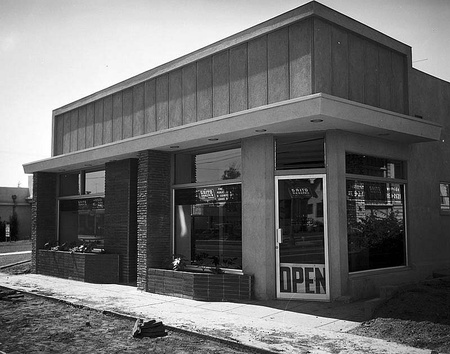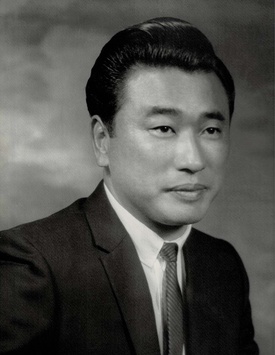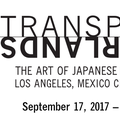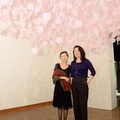Since 1910, Los Angeles has boasted the largest population of Japanese Americans in mainland U.S. This first-generation immigrant workforce vastly contributed to the city’s fishing, agricultural and produce marketing, and gardening industries. Early Japanese residents rented rooms in the segregated neighborhood downtown known as “Little Tokyo” until they married and began families. Thus began an expansion into small enclaves that welcomed non-whites, such as Boyle Heights, Sawtelle, Uptown, or near the fishing and cannery operations on Terminal Island.
Despite restrictive immigration and landownership laws, such as the Alien Land Law of 1913, which prohibited “aliens ineligible for citizenship” from owning land or holding long-term leases, or acquiring agricultural lands, the Japanese community developed workarounds, including placing land in the names of their Nisei children who had U.S. citizenship.
Sadly, upon returning to L.A. after years of wartime confinement, the Japanese were never able to regain that prewar prominence in the agriculture and produce industry. Instead, using their experience in horticulture, many immigrant Japanese worked as landscapers, gardeners, and domestics for wealthy white homeowners, which encouraged resettlement further from their previous community hub downtown to be closer to their client’s homes. In some cases, labor was exchanged for free room and board, which cut monthly expenses down tremendously and allowed enterprising Japanese to slowly build their savings.
By working tirelessly and pooling their combined funds, by the mid-1950s, Japanese families were finally positioned to purchase houses. To meet the postwar housing boom, numerous Japanese American real estate companies opened, which played a crucial role in developing properties and opening doors to families of color who were buying their first homes. This led to a migration of Japanese Americans and Blacks into the Southwest (known as “Seinan" for locals), Venice-Culver and Crenshaw districts after the war, just as urban renewal downtown began tearing down Little Tokyo for city expansion.

Newlyweds Yaeko and John Nagafuchi bought their first and only home in May 1967, moving from a cramped apartment to a three-bedroom house on Potomac Avenue in the popular Crenshaw neighborhood. “When we first saw the house we fell in love with it. Of course it looked like a castle after living in two apartments prior to the house,” reminisced Yaeko fifty-five years later and still living in her home. Wounds from the years their families spent incarcerated in World War II U.S.concentration camps at Heart Mountain, Wyoming and Poston, Arizona were still raw, but like so many Japanese Americans moving back to L.A., it was a return to home.
However, returning Japanese Americans quickly learned that L.A. was caught in one of the worst housing crises in the country—while they were pushed off the West Coast by the U.S. government, others were lured to California by jobs in the booming military industry. Many found that their stored belongings and other assets had been stolen or vandalized while exiled or were greeted with fierce discrimination and acts of terrorism.
To ease the transition, temporary non-government hostels and emergency housing in trailer parkers and former Army barracks opened. Those who could rent apartments or rooms in boarding houses often went back to their pre-war neighborhoods such as Boyle Heights or the West Jefferson area. Others moved to the South Bay’s Gardena and Torrance, where employment and housing restrictions were more relaxed.

Like Kaz Inouye, John was a WWII veteran. Many returning white veterans enjoyed the benefits of the G.I. Bill, which promised millions of veterans government aid for higher education and home-buying to its vets and acted as a gateway to homeownership for a generation. However, the guaranteed veteran benefits did not fund the loans directly. Veterans still had to secure financing from financial institutions, which was practically impossible for Asian American veterans, or even an Olympic diving champion like Sammy Lee, whom Inouye eventually represented.
Inouye later served as broker/developer for postwar houses in the area along the Centinela Avenue corridor. Building new homes catering to Japanese cultural needs meant including a big kitchen that could fit a table for the family to eat together at and lower countertops. Because Japanese women had shorter legs, the shelves and sink had to shrink to accommodate their diminutive heights. Outside, Inouye directed the homes to have a carport and a double garage with extra tall doors so the Japanese gardeners could drive in with their trucks loaded with brooms and lawnmowers.
“And the Japanese gardeners would [say], ‘Oh, kore wa ii. Oh, my God!—just want, I wanted’—I tell him, ‘Ojiisan, you know you don’t have to take your brooms down. You can go in with your rack.” Then we sold all the 10 houses. After that, then I started the building business. I started building myself and with a hakujin contractor, superintendent. We built a lot of homes. We called them Kashu homes over there.’”
With this large influx of educated, professional people of color, the neighborhoods themselves began to change and businesses in Crenshaw in particular, grew to reflect its Japanese and Black population. Crenshaw Square, a commercial development near 39th street and Crenshaw Blvd, built in 1959, was one of the first Asian American mall courts ever built. Emy Murakawa recorded some of her Crenshaw Square memories in an essay originally published by the Venice Japanese American Cultural Center:
“Crenshaw Square was originally conceived and planned to become the Little Tokyo of Midtown. Lots of Japanese shops and restaurants were there. Food Giant Market was there. It had its own Obon Festival and carnival. All the apartment houses with owners’ units on Bronson immediately behind Crenshaw Square were owned and rented by Japanese, and there was always a waitlist at Cren-Star Realty.
“Jefferson Boulevard was busy with Japanese establishments, too. Who remembers Tamura Furniture, Koby’s Drug Store Dr. Mizunoue’s office, Dr. Munekata’s office, Paul’s Kitchen, and Enbun Market across the street, and George Izumi’s original Grace Pastries? Crenshaw Square boasted a Sumitomo Bank, and Bank of Tokyo was on Jefferson. There were two Japanese theaters, too—Toho La Brea and the Kokusai Gekijyo.”
By the mid-‘60s, these racially integrated neighborhoods began to feel the strain. In 1952, a new immigration act was passed that formally ended Asian exclusion as a main pillar of U.S. immigration policy, even though it simultaneously strengthened the powers of the government to detain suspected subversives, echoing the arrests of Buddhist priests, Japanese language and martial arts instructors, and other community leaders, immediately following the attack on Pearl Harbor in 1941. The Act allotted immigration quotas to Japan and other Asian countries and eliminated race as a qualification for U.S. naturalization, which allowed Japanese and other immigrant Asians eligible to become American citizens for the very first time.
Japanese Americans gradually gained acceptance in the dominant culture, white efforts to further isolate and contain Los Angeles’ Blacks intensified to the point of violence, illustrating the real and lasting impacts of institutional racism.
“It was the beginning of the Sansei (third-generation Japanese American) exodus,” remembers Ken Kunishima, who moved to the neighborhood when he was eleven.
“The Nisei stuck around Seinan area, that’s where their roots, where their friends were. Some of them would move with their Sansei kids to Orange County, but the Nisei parents hated it. For them, it was very boring and they wanted to go back to the Crenshaw area.”
In 1980, Inouye and Chin decided to divide up the remaining satellite offices and to go their own ways. Inouye rebranded the business Kashu “K” (for Kazuo) Realty and Chin named his business ERA Kashu, joining a national franchise of associates.
True then as it is now, there is no sweeter prize for the Japanese immigrants who had suffered through the racism, exclusion, and wartime exile, than to hold the keys to their own home at last. It is a dream that Inouye and many others in his circle helped realize for many. “[My father] loved the business,” says Daro, “loved the fact that he was able to have satisfied customers and could speak Japanese. He had no sense of borders.”
© 2022 Patricia Wakida







